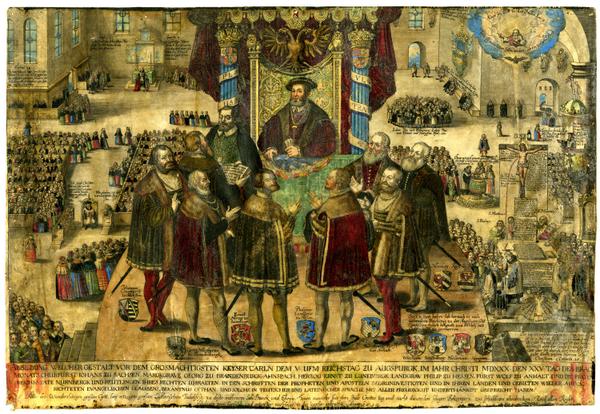1555 The Peace of Augsburg
Martin Luther’s 1517 attack on the doctrine of Purgatory and indulgences did not result, as he had hoped, in a reform of Catholic church practices; instead it led to wide-spread schism, violence and open warfare. German territories were particularly hard-hit as the hundreds of minor states that made up the Holy Roman Empire coalesced into rival camps, some professing Lutheranism, some Catholicism, and some religiously neutral. When the Emperor Charles V decided to use the force of arms to defend Catholicism, Protestant princes formed the Schmalkaldic League for self-defence. Though Charles defeated the League, he could not enforce a religious settlement on Germany, harassed as he was by the French on his western border and the Turks to the east. Worn out by the struggle Charles decided to abdicate and spend his last years in retirement in Spain.
The vast Habsburg empire that Charles had ruled was split. His son, Philip, was given Spain, the Netherlands, parts of Italy, and overseas holdings in Africa, the Americas and Asia. His brother, Frederick, was given the German lands and the title of Emperor. Philip was determined that no heretic should survive in his realms and continued the policy of war and persecution. Frederick opted for a policy of toleration by separation as set out in the Peace of Augsburg, negotiated between the Lutheran princes and Charles, before his abdication.

The main principle of the Peace, which largely ended sectarian warfare in Germany for several generations, was cuius regio, eius religio, or “whose kingdom, his religion”. The prince of each territory (either Lutheran or Catholic only, no provision was made for Anabaptist or Calvinist options) would determine the religion of his subjects. Those who did not wish to live under such a regime were given five years to sell up and move to a more congenial location. Despite some local breakdowns, the Peace was largely observed until the eruption of the tragic Thirty Years War in 1618.